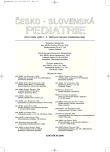Evaluation of Increased Levels of Neonatal Screening TSH in Slovakia
Authors:
S. Dluholucký 1,2; M. Knapková 2; M. Cibirová 2; F. Hrubá 3
Authors‘ workplace:
Klinika pre deti a dorost, Detská fakultná nemocnica s poliklinikou, Banská Bystrica
1; Skríningové centrum novorodencov SR, Detská fakultná nemocnica s poliklinikou, Banská Bystrica
2; Regionálny úrad verejného zdravotníctva, Banská Bystrica
3
Published in:
Čes-slov Pediat 2006; 61 (9): 524-529.
Category:
Original Papers
Overview
According the WHO and ICCIDD statement the increase of neonatal screening TSH value over 5 mU/ liter in more than 3% of the neonatal population in defined geographic area is the signal of the latent iodine deficiency in pregnant mothers, which represents a serious risk for optimal brain development of neonates.
The aim of the study was to evaluate the percentage of neonates with screening TSH over 5 mU/ liter in individual regions of Slovakia in 2002. The percentage of the screening TSH above 5 was 4.78 – 4.31 – 3.94 in West, Central, and East Slovak region fulfilling the criterion of the mild iodine deficiency in neonates. Normal iodine status is in whole population. The difference was more obvious in smaller regions (counties). Comparing the map of Slovakia after percentage of neonatal TSH above 5 (data from 2002 year) to the map expressing the frequency of endemic goiter (data from 1953 year), the significant negative correlation has been found. The highest percentage TSH over 5 was in agricultural regions and in regions with heavy PCB environmental pollution. It seems to be possible that high TSH over 5 percentage reflects not only latent iodine deficiency, but it may be the signal of negative influence of various environmental pollutants to the fetal-maternal thyroidal function (nitrites, PCB, etc.).
Key words:
fetal hypothyreosis, screening of congenital hypothyreosis, neonatal TSH, iodine deficit
Labels
Neonatology Paediatrics General practitioner for children and adolescentsArticle was published in
Czech-Slovak Pediatrics

2006 Issue 9
Most read in this issue
- Primary Disorders of Lipid Metabolism in Children – Our Experience
- Does Artificial Suckling Nutrition Pose a Risk of Atherosclerosis at the Adult Age?
- National Cholesterol Program in Children’s Population in Slovakia and Its Contribution
- Food Supplements with Fish Oils – The Composition of Fatty Acids
